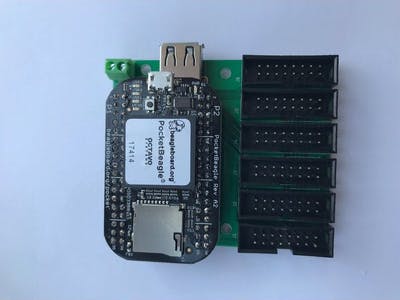Categories: Intermediate
What is it?
It’s a cape for the PocketBeagle that provides six HUB75 output connectors for driving standard P10/P5 panels.
Why did you make it?
P10 and P5 LED panels have become a popular method of displaying images, text, and effects for animated Christmas Light displays. Traditionally, the community has been using an "Octoscroller" on a full Beaglebone Black for driving the panels. This cape provides much of the same functionality, but for the smaller/cheaper PocketBeagle.
What makes it special?
The PocketScroller has six output connectors, each of which can drive more that 12 P10 1:8 scan panels for a total panel count of 72. It supports the 1:4 scan P10 panels, 1:8 scan P5 panels, and 1:16 scan P5 panels. Other panels types that use the 1:8 or 1:16 scan rates are also supported.
The FPP software that runs on the PocketBeagle is capable of playing sequences off the local SD card, but can also accept e1.31 or DDP data via a network adapter plugged into the USB port. (WIFI or Ethernet) Any software that can output e1.31 should be able to send effects to the PocketScroller for display on the Panels.
The FPP software uses both PRUs on the PocketBeagle to drive the panels. This allows a very high refresh rate while freeing up the main CPU to handle the network IO and general panel layout.
All software and PRU code is open source and available on github.
The cape provides:
- Six HUB75 output connectors
- USB-A connector for a USB ethernet or wifi adapater
- 3.5mm screw terminal for providing 5v power. This provides power to the PocketBeagle, the buffer chip, and the USB bus.
You will need:
- A PocketBeagle
- The PocketScroller – can be purchased from Tindie:
https://www.tindie.com/products/dkulp/pocketscroller-led-panel-cape-for-pocketbeagle/
- A good quality SD card with the latest FPP image installed on it. The latest FPP images can always be found at
http://dankulp.com/bbb/
- A USB network adapter – Ethernet is preferred for initial setup, but WiFi (adapter must be supported by Linux/Beaglebone/Raspberry Pi) can also work if you use a micro USB cable to connect to the PocketBeagle to do the WiFi setup.


Comments are not currently available for this post.